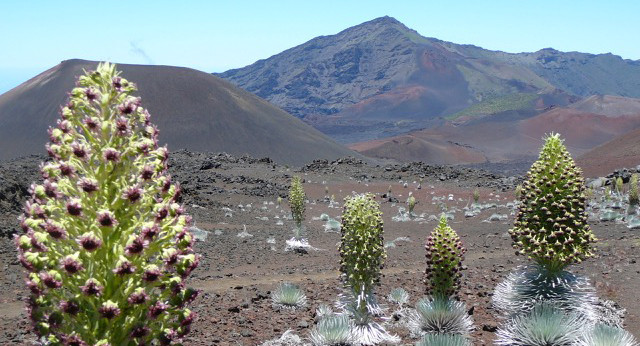The National Park Service turns 100 years old in 2016, and so does Hawai‘i Volcanoes National Park on Hawai‘i Island and Haleakalā National Park on Maui.
Hawai‘i Volcanoes National Park is located 30 miles southwest of Hilo on Hawai‘i Island. The park encompasses over 333,000 acres that reaches the summit of Maunaloa all the way to the sea. You can hike 150 miles of trails that traverse the volcanic crater, arid deserts, rainforests and a walk-in lava tube. Home of Kīlauea Volcano, one of the most active volcanoes on earth, this national park is one of the most popular visitor attractions in Hawai‘i and a sacred place for Native Hawaiians.
Hawai‘i Volcanoes National Park invites you to commemorate a century of stewardship by joining a Centennial Hike series and corresponding After Dark in the park programs, the annual Hawaiian Cultural Festival & Bio Blitz and much more.
Spanning 30,000 acres Haleakalā National Park stretches across Maui’s southern and eastern shore, the slopes of this dormant volcano are visible from most of the island. The park showcases Haleakalā Crater that rises over 10,000 feet above sea level. Haleakalā means “House of the Sun” in Hawaiian so it is apropos that sunrises and sunsets at this altitude are priceless! Your visit here might include a glimpse of rare native birds and plants, a hand-on experience with Hawaiian culture, a walk through bamboo forest or a hike in a moonscape-like setting while the sun warms you. There are ranger-guided programs, lots of hiking trails and drive-up camping as well as remote camping in the backcountry.
Whatever you choose to do at either of these two Hawai‘i National Parks be prepared. Bring sun protection and at these high elevations it is surprisingly cold and sometimes wet so raingear, jackets, pants and sturdy shoes are de rigueur. There is no food for sale in the parks. There are restrooms and drinking water at the visitor centers. So be sure to bring water and snacks if you are hiking. The parks are open 24 hours per day 365 days a year except during extreme weather events. The visitor centers are open during the day. Your trip to these volcano parks will take at least half a day or all day depending on what you choose to do when you get there.
As part of the Centennial Celebration all national parks will waive entrance fees on 16 special days in 2016. And Hawai‘i Volcanoes National Park will offer one additional fee-free day Aug. 1, 2016, in celebration of its 100th birthday.
The 17 fee-free days in 2016 are:
Jan. 18, Martin Luther King Jr. Day
April 16-24, National Park Week (nine fee-free days)
Aug. 1, Hawai‘i Volcanoes National Park 100th birthday
Aug. 25-28, National Park Service Birthday Weekend (four fee-free days)
Sept. 24, National Public Lands Day
Nov. 11, Veterans Day
Learn More: https://www.nps.gov/hale/planyourvisit/things2do.htm (about Haleakala visit)


